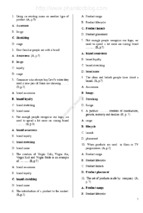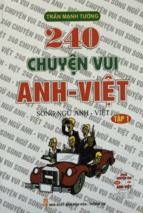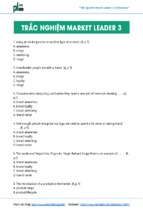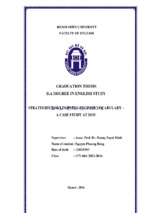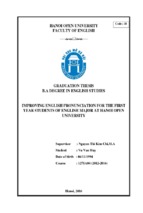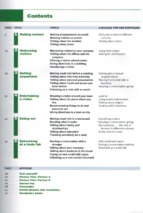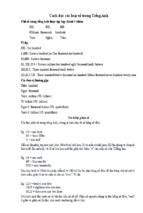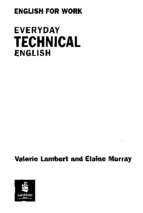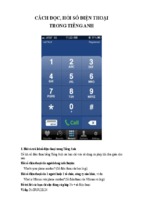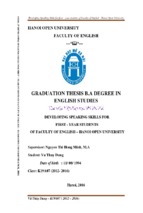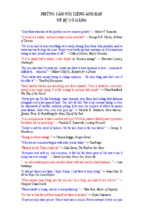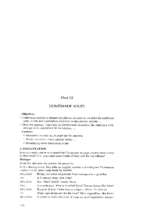HANOI OPEN UNIVERSITY
CODE: 16
FACULTY OF ENGLISH
GRADUATION THESIS
B.A DEGREE IN ENGLISH STUDIES
A DISCOURSE ANALYSIS ON
SOME OF BRITISH QUEEN’S CHRISTMAS
MESSAGES 1952 – 2015
Ha
Supervisor
: Lưu Chí Hải, MA
Student
: Đỗ Minh Thu
Date of birth
: 01/10/1994
Class
: 1271A04 (2012 – 2016)
Noi
–
2016
GRADUATION PAPER
Declaration
Title:
A Discourse Analysis on Some of British Queen’s Christmas Messages
1952 – 2015
I certify that no part of the report has been copied or reproduced by me from
any other’s work without acknowledgement and that the report is originally
written by me under strict guidance of my supervisor.
Hanoi
Student
Supervisor
signature
signature
Full name
Full name
Do Minh Thu - 1271A04 (2012 - 2016)
3
GRADUATION PAPER
Acknowledgement
First and foremost, I would like to express my deep gratitude to
my supervisor, Mr. Luu Chi Hai, MA. for his time and effort
guiding me and identifying the flaws in my draft. This paper was
completed owing to his instruction and valuable advice.
Secondly, I want to give credits to all my teachers who taught
me countless lessons, enriching my knowledge in English
throughout my four years in the university.
I would also want to send my thanks to my family and friends
who have continually shown support to keep me always inspired to
work hard on the thesis.
Do Minh Thu - 1271A04 (2012 - 2016)
4
GRADUATION PAPER
TABLE OF CONTENTS
Declaration...................................................................2
Acknowledgement.......................................................3
I
I ntr o ducti o n. .. .. .. .. .. . .. .. .. .. . .. .. .... ... .. .. .... . .. .. .... . .... .... . .. .8
II
Theoretical Part..........................................................9
2.1
Discourse Analysis.............................................................9
2.1.1
Discourse...................................................................9
2.1.2
Discourse Analysis....................................................12
2.1.3
Methods of discourse analysis...................................13
2.1.4
Perspectives of discourse analysis...............................13
2.1.4.1 Written and Spoken language............................13
2.1.4.2 Grammatical cohesion......................................18
2.1.4.3 Lexical cohesive devices....................................22
2.1.4.4 Pragmatics.....................................................25
Do Minh Thu - 1271A04 (2012 - 2016)
5
GRADUATION PAPER
2.1.4.5 Style.............................................................26
2.2
The Christmas message.................................................26
III
Practical Part...............................................................28
3.1
Language........................................................................28
3. 2
Grammatical cohesion.....................................................28
3.2.1
Length and structure of sentences..............................29
3.2.2
Reference................................................................31
3.2.3
Substitution................................................................33
3.2.4
Ellipsis...................................................................34
3.2.5
Conjunction...........................................................34
3.2.6
Summary...............................................................35
3.3
Lexical cohesive devices................................................35
3.4
Vocabulary.....................................................................36
3.4.1
Topics........................................................................36
3.4.2
Frequently used words....................................................38
3.4.3
Pronouns...................................................................39
3.4.4
Summary.................................................................40
Do Minh Thu - 1271A04 (2012 - 2016)
6
GRADUATION PAPER
3.5 Style..............................................................................40
3.5.1
M etap h o r.. .. ........ ....... .. .. .. .......... .. ..... .. .. .. ........ .. .40
3.5.2
S i mi l e . . . . . . . . . . . . . . . . . . . . . . . . . . . . . . . . . . . . . . . . . . . . . . . . . . . . . . . . . . . 4 1
3.5.3
Parenthesis...........................................................41
3.5.4
C it ati on s .. .. . .. .. .. .. . .. .. .. .. ... .. .... .. . .. .. .. .. ... .. .... .. ... .. .41
3.5.5
Rhetorical questions................................................42
3.5.6
Personification...........................................................42
3.5.7
Poetry......................................................................42
III
Conclusion....................................................................44
IV
Reference.....................................................................45
V
A ppe ndi x .. .. .... . .. .. .. .. .. . .. .... .. ... .. .... .. . .. .. .. .. ... .. .... . .... .. .4 7
Do Minh Thu - 1271A04 (2012 - 2016)
7
GRADUATION PAPER
LIST OF TABLES
Table 1. Differences between written and spoken language..........14
Table 2. Frequently used conjunctions....................................35
Table 3. Speeches topics.......................................................35
Table 4. Frequentl y used nouns.............................................38
Table 5. Frequently used verbs..............................................38
Table 6. Frequently used adjectives...........................................39
Table 7. Frequency of the use of pronouns...............................39
Do Minh Thu - 1271A04 (2012 - 2016)
8
GRADUATION PAPER
I. INTRODUCTION
Christmas is considered the most important holiday in Britain – a
country whose most of the citizens identify with Christianity. The Royalty has
been presenting the traditions and religion in many aspects, one of which is
their Christmas celebration.
The Christmas message, started by King George V in 1932, has received
a great concern from the public and been passed on through three reigns. The
Queen Elizabeth II has been praising traditional values and maintaining the
tradition set up by her grandfather to express solidarity with her people in
good as well as bad times. The Christmas speeches are one of the outstanding
examples of preserving this tradition. Therefore, it is fascinating for me to do
a research about Christmas speeches’ origin and typical features in words and
style. The speeches are typical formal texts produced by native English
speakers. The discourse analysis of Queen’s speeches is indeed a challenging
task; however it is truly helpful for English learners, especially those who are
taking discourse analysis course.
Every year, the Queen Elizabeth II delivers a Christmas speech from
Buckingham Palace on December 25th. Through out 64 years of her reign, she
has sent 63 Christmas messages. This study will deal with the Christmas
messages in 1952, 1954, 1962, 1997, 1998, 2000, 2005 and 2015, consisting
of 8 speeches of well over 5,300 words in total.
In this study, the most used method is data gathering and analysing. The
text will be analysed in several levels such as grammatical, lexical and
stylistic; and we will also try to look into diachronic changes and describe
them.
Do Minh Thu - 1271A04 (2012 - 2016)
9
GRADUATION PAPER
II. THEORITICAL PART
2.1
Discourse Analysis
2.1.1 Discourse
Let us consider the following extracts:
Extract 1:
The tailor was quite willing, and he followed him. When they reached the
den there sat some other giants by the fire, and each had a roasted sheep in
his hand, and was eating it. The little tailor looked around and thought,
‘There is more elbow-room here than in my workshop.’
(J.L.C & W.C. Grimm, 1993)
Extract 2:
A: The hell with the boat, Balthazar ?
B: What boat ?
A: The Titanic.
B: Oh! Yeah. The Titanic. Yes, well, it was meant to sink. And I saved it.
(Supernatural series– season 6, episode 17, 2011)
Extract 3:
Do Minh Thu - 1271A04 (2012 - 2016)
10
GRADUATION PAPER
In most western countries, child-rearing is now accepted as the
responsibility of both parents. Undoubtedly , public interest in folk music has
declined. Therefore, although students may gain knowledge from the internet,
the skills and ideas ultimately emanate from the teachers. There is nothing
better than keeping a cat or a dog if you want your kids to be more
independent and responsible.
� Conclusion:
Extract 1 and 2 are discourses because the sentences in the first extract
and the utterances in the second one are related in terms of the ideas or
communicative functions that they share. On the contrary, extract 3 consists
of unrelated sentences collected from different texts and they do not share a
common idea, therefore it is not a discourse.
Many linguistics experts have given discourse definitions according to
their own understanding. The followings are possibly the most simple and
understandable for learners:
−
Discourse is a connected series of utterances; a text or conversation.
(Oxford dictionaries)
−
Discourse is language that is functional – language that is doing some
job in some context as opposed to isolated words or sentences.
Discourse can be spoken, written or in any other medium of
expression.
Do Minh Thu - 1271A04 (2012 - 2016)
11
GRADUATION PAPER
Discourse is a unit of language in use. It is not a grammatical unit, like
a clause or a sentence.
Discourse is a semantic unit, a unit not of form but of meaning. A
discourse does not consist of sentences; it is realized by, or encoded in
sentences.
(Halliday M.A.K & Hasan R., 1976)
From Halliday & Hasan’s definition, it can be inferred that a discourse
can be realized by a word (e.g. hey, great, wow); a phrase (e.g. no smoking,
those withered daisies); a clause or sentence (e.g.: as time goes by; they left
this morning); one or several paragraphs; one or several books.
According to Bell R. T. (1991), there are seven criteria help to identify a
discourse which are also a discourse’s inherent features:
• cohesion
• coherence
• intentionality
• acceptability
• informativity
• relevance
• intertextuality
Do Minh Thu - 1271A04 (2012 - 2016)
12
GRADUATION PAPER
2.1.2 Discourse analysis
Discourse analysis is a branch of linguistics dealing with the largest unit
of language in communication – discourse, referring to a number of
approaches to analyze written, vocal, or sign language use, or any significant
semiotic event.
The term first came into general use following the publication of a series
of papers by Zellig Harris which began in 1952. In the late 1960s and 1970s, a
variety of other approaches to a new cross-discipline of discourse analysis
began to develop in most of the humanities and social sciences concurrently
with and related to other disciplines such as semiotics, psycholinguistics,
sociolinguistics, and pragmatics. Many of these approaches, especially those
influenced by the social sciences, favour a more dynamic study of oral talkin-interaction.
While Cook claimed discourse analysis as the search for what gives the
language in use coherence, Brown and Yule, however, focused primarily on
the importance of pragmatics when analysing a discourse believing that
discourse analysis must involves syntax and semantics but it primarily
consists of pragmatics.
Discourse analysis learners might know how to adjust their knowledge to
a particular context in order to communicate their message clearly. The
findings
of discourse analysis help to uncover the natural patterns of
communication and theirs application help the users to achieve successful
communication.
Do Minh Thu - 1271A04 (2012 - 2016)
13
GRADUATION PAPER
2.1.3 Methods of discourse analysis
Discourse analysis has gained a significant place in the study of language
and it is rapidly expanding. There are several ways to analyse a discourse.
Brown and Yule focus on the discourse level and pragmatics of the text,
they describe the role of context in interpretation, discourse topic,
thematisation and staging, information structure, cohesion and coherence.
Crystal and Davy divide discourse analysis into several levels consisting
of phonetic, phonological, grammatical, lexical and. They further notice
that more levels may be needed or a level within the mentioned levels
may be established if the text requires doing so. They suggest to start with
an independent analysis at each level using the techniques developed in
linguistics for them (Crystal, 1989).
This thesis, inspired by all four authors, will analyse discourse at the
levels of grammatical, vocabulary, stylistic and pragmatics.
2.1.4 Perspectives of discourse analysis
2.1.4.1 Written and spoken language
Spoken language is language produced by articulate sounds. Some most
significant features of spoken language are paralinguistic, sound and emotions.
Sounds and emotions are expressed through intensity of voice, intonation and
pitch range. Spoken language also depends on non-verbal language such as
body language, facial expression.
Do Minh Thu - 1271A04 (2012 - 2016)
14
GRADUATION PAPER
Written language is language presented through writing system. The
writer usually express emotion and attitude through the choice of words and
punctuations, therefore the reader is required to have a certain knowledge to
fully understand a written text.
Both two types of communication share same purposes: to deliver
information, to complete tasks or to entertain. On the other hand, they differ
in three aspects namely situation, grammar and lexical density (Van H. V.,
2006).
a) Situation
Regarding situation aspect, the speaker and writer produce texts in
divergent ways. The table below is the summary of some notable differences
between these two language in terms of the situation they are produced:
Written Language
Spoken Language
− situation inferred from the text
− face-to-face interaction
− writer has time to choose
− speaker is under pressure to
linguistic devices
produce text immediately
− words carry all shades of meaning − meaning expressed through text,
intonation, pitch, body language
and facial expression
− reader making assumptions about
the writer’s state of knowledge,
− instant interaction between speaker
and listener
opinions and intentions
Table 1. Differences between written and spoken language
Do Minh Thu - 1271A04 (2012 - 2016)
15
GRADUATION PAPER
b) Grammar
i)
The written text often have more information packed into smaller
amount of words
e.g. 1: Investment in a rail facility implies a long-term commitment.
e.g. 2: If you invest in a rail facility, this implies that you are
going to be committed for a long term.
ii)
Linguistically, written language tends to consist of internally
complex clauses, whereas the complexity in spoken language
exists in the way clauses are connected.
e.g. 1: This morning at half past eleven, Associate Professor Dean
Wolfe will present a programme entitled ‘The Science of Music’,
in which the listener will experience a number of fascinating
things, including music played backwards – although most will be
played forwards.
e.g. 2: This morning Associate Professor Dean Wolfe will talk
about the science of music at half past eleven, and we’ll hear some
fascinating thing such as music backwards – but most of it will be
played forwards!
(Van H. V., 2006)
iii)
Spoken language has much less complex structured syntax than
that of written language
iv)
Spoken language contains many incomplete sentences
v)
Spoken language typically contains rather little subordination
Do Minh Thu - 1271A04 (2012 - 2016)
16
GRADUATION PAPER
vi)
In spoken language, active declarative forms are normally found
passives are less common
vii)
In spoken language, and, but, then, if are frequently used
connectors. Common clauses markers in written language are that,
while, furthermore, moreover, correspondingly, etc.
viii) The speaker is typically less explicit than the writer.
ix)
In written language, heavily modified noun phrases are regularly
used
e.g. A man who turned into a human torch ten days ago after
snoozing in his locked car while smoking his pipe has died in
hospital.
It is rare to find adjectives with more than two pre-determiners in
spoken language
e.g. It’s a big tabby cat + with torn ears.
x)
Whereas written language sentences are generally structured in
subject-predicate form
e.g. The cats were left outside.
Spoken language sentences are usually in topic-comment structure
e.g. The cats + they were left outside.
xi)
In written language, the occurrence of passive constructions is
more frequent
Do Minh Thu - 1271A04 (2012 - 2016)
17
GRADUATION PAPER
xii)
In spoken language, the speaker may rely on non-verbal language
like gaze or pointing direction when chat about the immediate
environment
e.g. (looking at the rain) We might have to stay the night.
xiii) The speaker may replace or refine expressions
xiv) The speaker typically uses various generalised vocabulary: a lot of,
got, do, thing, stuff, nice, things like that, etc.
xv)
The speaker frequently repeats the same syntactic form several
times
e.g. I look at fire extinguisher + I look at fire exits + I look at the
available gangways + I look at electric cables + are they properly
earthed + are they properly covered.
xvi) The speaker may produce a large number of prefabricated filters:
well, you know, erm, yeah, so on, you see, etc.
(Brown & Yule, 1983)
c) Lexical density
Functionally, there are two kinds of words: lexical and function words.
− A lexical word refers to a thing, quality, state, action or event.
− A function word indicates only grammatical relationships.
Lexical density refers to the number of lexical words in a clause.
e.g. My father is very experienced in engineering.
Do Minh Thu - 1271A04 (2012 - 2016)
18
GRADUATION PAPER
In the sentence, the lexical words are father, experienced, engineering;
the function words are my, is, very, in.
2.1.4.2 Grammatical cohesion
Grammatical cohesion is the surface marking of semantic link between
clauses and sentences in written discourse, and between utterances and turns
in speech.
(Trung H. N., 2014)
Grammatical cohesive devices include reference, substitution, ellipsis
and conjunction.
(Halliday & Hasan, 1976)
a) Reference
Definition:
Reference expresses the relationship of identity which exists between
units in discourse, helps readers interpret the text.
e.g. Barack Hussein Obama II (born August 4th, 1961) is the 44th and
current President of the United States. He is the first African American
to hold the office. Obama previously served as a United States Senator
from Illinois, from January 2005 until he resigned following his victory
in the 2008 presidential election.
(Trung H.N., 2009)
Do Minh Thu - 1271A04 (2012 - 2016)
19
GRADUATION PAPER
Classification:
Reference
pointing direction
exophoric
reference realization
endophoric
personal
i)
demonstrative
comparative
Exophoric references refer to assumed, shared worlds outside the
text
ii)
Endophoric references refer to entity within the text either
backwards (anaphoric) or forwards (cataphoric)
iii)
Personal references are expressed through personal pronouns,
possessive pronouns and determiners.
iv)
Demonstrative references help speaker to identify the location of
the reference on a scale of proximity.
v)
Comparative references are expressed through adjectives and
adverbs in comparison items within a text in terms of identify or
similarity.
Do Minh Thu - 1271A04 (2012 - 2016)
20
GRADUATION PAPER
b) Substitution
Definition:
Substitution is a relation within the text on the lexico-grammatical level.
A substitute is sort of counter used in place of the repetition of a particular
item.
(Halliday & Hasan, 1976)
Classification:
There are three types of substitution: nominal, verbal and clausal
substitution.
i)
Nominal substitution is the use of a substitute item to replace the
head noun of a corresponding noun phrase. Presupposed noun is
always a count noun, mass noun does not have substitute form.
ii)
Verbal substitution is expressed through do, do so, do it and do
that.
e.g. 1: I tried to find out who set the house on fire that day. Until
now, I still believe that it was Tom’s little sister who did it.
e.g. 2: Mike’s been blaming himself that he did not comeback for
Christmas last year. If he had done so, things would not have been
that way.
e.g. 3: When I told him I was going to book a flight ticket on the
Sunday, he told me not to do that.
iii)
Clausal substitution is expressed through so and not. Used as a
clausal substitute, so presupposes a whole clause, and not is taken
as its negative equivalent.
Do Minh Thu - 1271A04 (2012 - 2016)
21
- Xem thêm -


